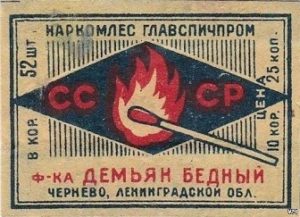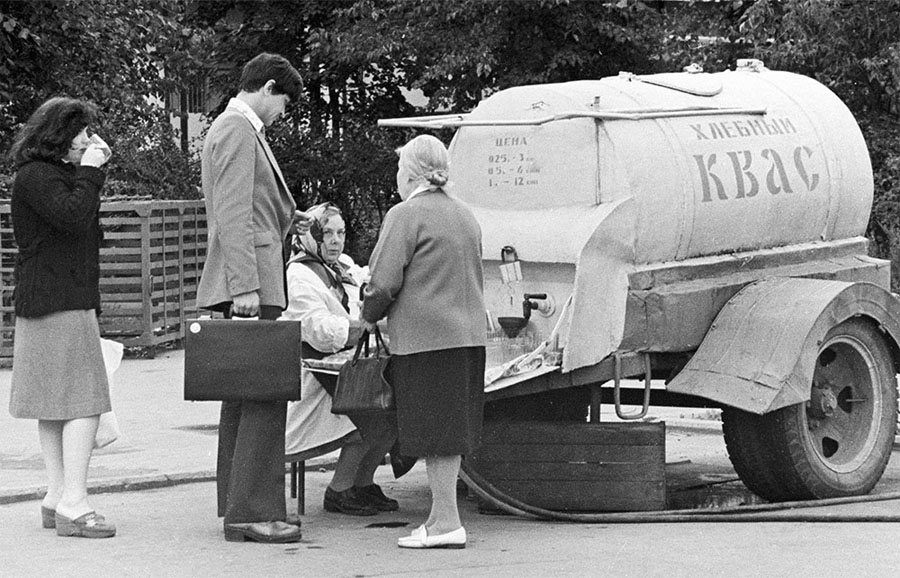Russian folklorists Anna Kirziuk and Alexandra Arkhipova are the authors of the first book about urban legends in the Soviet Union. Corpses in kvass barrels, dangerous signs hidden by the enemies of the people, black Volga kidnappings … Do these tales reflect the Soviet fears ? What can we think of the most recent “Blue Whale Challenge” rumours, which started in Russia ? We had the opportunity to interview these urban legends specialists about this quite unknown subject.
This article is translated from an interview in French by Anna Kirziuk and kindly proofread by Ian Brodie, associate professor of folklore at Cape Breton University.
The Dangerous Things in Soviet Urban Legends (Novoe Literaturnoe Obozrenie, 2019, in Russian) is the first book about rumors and urban legends in Soviet Russia and the collective fears that underlies them. What motivates you to study this specific aspect and period of Russia’s history ?
Rumors and urban legends had a special status in the USSR because of intense censorship. The Soviet people were always aware of the incompleteness of official information. Therefore, the degree of trust in unofficial sources (such as “my friend’s sister heard”) was very high. In 1947, sovietologists surveyed defectors from the USSR about their usual sources of information in everyday Soviet life (the so called “Harvard Project”). According to the defectors, 74% of them regularly discussed rumors in conversations with friends; 50% stated that rumors were regular source of information for them; and 22% of clerks, 41% of workers and 73% of peasants pointed to rumors as the most important source of information.

Alexandra Arkhipova (on the right) is a senior research fellow at the Laboratory of Theoretical Folkloristics / Russian Presidential Academy of Public Administration. Contact : alexandra.arkhipova@gmail.com.
Censorship displaced an enormous layer of knowledge in the sphere of informal oral communication. For instance, if we study American urban legends of the 1970s, we can discover many stories were also in newspapers of the time. But we cannot find in Soviet newspapers the stories that people told each other as they stood in the daily queues. Instead, we find them in diaries and memoirs. It is very important to collect these stories right now when we are able to still question people who remember the Late Soviet period very well.
There is another reason for the need to study the Soviet urban legends. In contrast to the United States or France, Soviet rumors and urban legends were not studied during the Soviet period. They have been collected exclusively by KGB officers whose goals were not scientific at all.
Dangerous Signs
USSR has a 70 years history. Did periods such as the Great Terror or the fall of Soviet Union generate specific rumors or urban legends ? Is it possible to trace, in some way, an history of fears in the USSR ?
In a sense, our book is a history of Soviet fears. We did not study legends about the collapse of the USSR: that is a separate topic. But we can trace the evolution of some stories from the 1930s to the 1980s.
For example, the story about “dangerous signs” appeared during the Great Terror. In 1936-1938, when Stalin’s show trials of the “enemies of the people” were held, Soviet people told each other stories about hidden signs (swastikas, Trotsky’s face or anti-Soviet slogans) that had been supposedly left on ordinary Soviet things by disguised “enemies” (Picture).

An appeal to find these hidden signs was launched by the Soviet authorities. Newspapers repeated that “the enemies of the people” operated everywhere and that they were indistinguishable in their appearance from loyal Soviet citizens. Censors and editors were strictly instructed to examine printed products more carefully so as not to miss any such sign, which could be hidden in the hatching of the picture, or in a combination of drawings and letters. A newspaper editor or an artist could pay for their lack of “vigilance” with their freedom and even with their life.
But very soon the search for “dangerous signs” became a sort of mania: ordinary people began to look for and find such signs everywhere – in a label on a matchbox, in a clip for a pioneer tie, in cakes from a local store, on buttons and ceremonial portraits of Soviet leaders. This massive search for signs and the widespread rumors about new “discoveries” become a folk expression of a worldview where nothing is what it seems and where a disguised enemy could be hiding behind every object. A panic arises, and children refuse to wear clips for a pioneer tie that, according to rumors, contain the hidden initials of “enemies of the people” Trotsky and Zinoviev. At some point the Soviet authorities recognized that they needed to stop the avalanche of these rumors immediately, but they did not not really understand how to do it.
After the Great Terror, the idea of hidden dangerous signs present in everyday Soviet life did not disappear completely. In the 1960s, stories about a local building that supposedly had the shape of a swastika emerged in different cities of the USSR. These were allegedly built after WWII by German prisoners of war, or were constructed by German architects who worked in the USSR before the war. However, in the late Soviet era, such stories no longer evoked fear. They were perceived as curious facts of a city’s history, and the alleged swastika buildings became the sites in the urban landscape. These stories are based on the same idea of a hidden enemy sign as the rumors from the 1930s, but there was no more real fear of the “enemy,” and the state no longer punished for insufficient “vigilance.” Therefore, late Soviet legends about swastika buildings were not the cause of large-scale panics, as it was during the Great Terror, but instead circulated as entertaining stories.
The Cat Corpse in the Kvass Barrel
Your work shows the existence of urban legends very similar to those that existed in West Europa and the USA ; legends about the dangers of industrial food or specific public places. When did these legends appeared in USSR ? Are they linked to a certain fear of technological progress and social changes ? Or did they reflect the anonymity of the urban environment ?
Soviet society was very different from the American one, for example, and the country was separated from the rest of the world by the Iron Curtain. However, Soviet consumer rumors were surprisingly similar to rumors in the Western Europe and the United States. The difference was in the details. In Western countries, people told “revelatory” stories about the products of big corporations, while in the USSR similar stories were told about food products of the state-owned enterprises. A classic Western story concerns a consumer who finds a rat tail in a KFC burger or in a can of Coca-Cola. There were no such big corporations in the USSR, but Soviet people told similar stories about sausages manufactured by a local enterprise. We can document such stories since the 1960s. The most widespread rumor was about a meat-packing factory where rats were so numerous that they fell into a vat with minced meat, were ground up, and then ended up in sausage. The narrator often referred to a friend from the meat-packing factory who allegedly saw the disgusting scene with their own eyes.
The similarity of these rumors is related to the fact that, just as in the West, in the USSR people began to consume more and more industrially-prepared food. When we eat at home or in a familiar restaurant on the corner, we know how our food is prepared. When we eat in chain restaurants or buy ready-to-cook foods, our food is made by some unknown people somewhere out of our sight. Hence, there are suspicions common to visitors of both McDonald’s and Soviet state food stores.
A resident of a big city is faced with many strangers every day. They are forced to share various urban places, from the subway car to the playground, with these anonymous others. they are also forced to buy goods and services from strangers. In the West, this anxiety about the anonymity of contacts in a big city was often expressed in stories about dangerous food prepared by an ethnic other. A classic example is a story about a person who contracts a dangerous (often sexually-transmitted) disease after dining at an ethnic restaurant.

Soviet rumors more often told about the dangers of shopping from strangers who were not an ethnic “other,” with the danger arising instead from the fact that the sellers were not personally known to the buyer. For example, in the summertime kvass (a non-alcoholic beverage) is sold from barrels on the streets of Soviet cities. There were rumors that at the bottom of a kvass barrel someone found the corpse of a dog or cat. With reference to this story, parents advise their children to only buy kvass from a seller that they know (Picture 2). We assume that this urgent concern about “unknown sellers” arose from the specifics of Soviet urbanization, which was accelerated and rapid. Thousands of people moved from the village context where everyone knew each other, and they could not immediately get used to the new type of anonymous urban interactions. Furthermore, exchanges of goods and services based on personal contacts were an important part of the everyday life of almost every Soviet person, because these practices helped to compensate for chronic shortages. Such pre-modern economic practices supported the habit of looking for acquaintances everywhere – in a store, in a market, in a dental clinic and so on.
The Black Volga Kidnappers
Moral panic about the presence of ‘white van kidnappers’ are very common in France and Belgium, especially in the recent years. The French and Belgian opinion is indeed deeply marked by pedocriminal cases such as the Dutroux and Fourniret affair. As Aurore Van de Winkel remarks, these two criminals used to kidnapp their victims with white vans. In Soviet Poland and Russia we can find similar legends, except that the vehicule is always a black Volga. In view of the fact that they were used by the KGB or Party members, can we deduce that these kidnapping legends are more ‘political’ in USSR ?
The story about kidnappers in a car is very common, and it appears in very different cultural contexts. We often see a sort of “plot homonymy”: stories that are very similar at first glance can actually speak about different things and carry out different functions. In the USSR, there were three legends about the black car.

The first legend circulated in the 1950-60s and said that Lavrentii Beria, one of Stalin’s closest associates, would his black car around Moscow, looking for attractive girls and women and pulling them into the car.
The second legend appeared in the 1980s: a black Volga–driven either by priests, Jews, foreigners or KGB officers–allegedly kidnapped children to drain their blood and “send it abroad in special containers”. This legend was very popular in socialist Poland, but was not widespread in the USSR. It was one of numerous variants of organ theft legends, which in the 1990s caused major panic in Latin America where wealthy foreigners were also accused of kidnapping children (see more about this in the book by Véronique Campion-Vincent).
And finally, the third legend told about a black Volga that supposedly abducted children with an incomprehensible purpose and in an incomprehensible way. This story existed in the 1970-1980s among children, but it expressed an adult fear of violence from the state. This legend did not tell who was sitting in the black car, and it said nothing about why the Volga’s driver abducted children nor where they found themselves after this abduction. In the language of children’s horror stories, this legend described a typical arrest situation during the Great Terror, when a person could be taken away by a black car and disappear forever, with their relatives not knowing anything about their fate for many years.
The Red Film
You describe a game common amongst Soviet childrens which consisted in imitating Lavrenti Beria kidnapping young girls in the streets of Moscow. The existence of a “red film” which allows its possessors to see what’s underneath the clothes is an other urban legend which was popular in the Soviet schoolyards. It was specially use as a means of blackmail. You associate these urban legends with the development of remote means in the 70s and 80s. How can we read this appropriation of espionage and power relationships by Soviet childrens ?
In the late Soviet era, the state control over citizens became predominantly by remote means – wiretapping, censorship, photo surveillance. Among urbanites (and especially among the opposition-minded intelligentsia), there were many stories about super-powerful KGB devices that could violate a person’s privacy by, for example, seeing and listening through walls and windows of apartments. At the same time, children spoke about a special device, typically a red camera film or red-lensed glasses, which allegedly allowed the user to see clothed people as fully naked. Some French schoolchildren in the 1990s also heard about such a device, but they were never through its use under threat of blackmail. This is an important distinction. In the Soviet schools, the “holder” of the red film blackmailed classmates with the threat of producing “naked pictures” and in this way were granted unlimited power within the children’s group. Thus, the children not only articulated the “adult” fear of being defenseless against the all-pervasive eye of the authorities, but also compensated for it: with the help of their own “red film” every child could find themselves in the position of the authorities and violate the privacy of others.
We think that the story about the “red film” (as well as the story of the “Black Volga”) is the result of children adopting and adapting adult fears. Children were not interested in KGB devices, which for them were irrelevant. But they felt that they were living in a society where privacy was very fragile and could be violated in any moment. The legend of the magic film helped them to cope with this feeling.
Did the Soviet authorities have an interest in these urban legends, such as the Lavrenti Beria one ? Did they try to interfere in their diffusion ?
The Soviet secret political police (which in different periods was called NKVD, MGB, or KGB) closely monitored the mood of the people, which, in the opinion of this agency, was expressed most precisely in their rumors and legends, as well as in their jokes. Before Stalin’s death in 1953, the NKVD-MGB regularly collected so-called “public mood reports”, where people’s statements on political and economic topics, including rumors, were recorded. In 1930-1940s, a person could be arrested and sentenced to a labor camp for spreading certain rumors.
After Stalin’s death, the Soviet authorities began to lose their interest in rumors – at least, they no longer made arrests for propagating them. Fighting rumors through media campaigns was practically impossible. To refute a rumor, one has to tell it publicly and acknowledge the problem that caused it. Both actions were contrary to the principles of Soviet journalism.
The Soviet government was interested in legends and rumors about political leaders, but we are not aware of any arrests for rumors about Beria.
The Blue Whale Challenge
In France, we spoke a lot of the “Blue Whale Challenge” which emerged in 2017 as a chain of progressive challenges imposed by “curators” to teenagers for the purpose of leading them to suicide. Authorities and local press helped to spread the rumor with stories of runaways and suicides allegedly attributed to the Blue Whale Challenge. The existence of such challenges were, however, difficult to prove [link in French]. According to the French press, the Blue Whale appeared in Russia, in the form of “Death Groups” in social network VKontakte. Did these groups existed in Russia ? Can we attribute teenagers suicide with the existence of these groups or suicide challenges ? Or is it an other urban legend ?
It is an urban legend that, in fact, first appeared in Russia and then became widespread in some other countries. It all started with “The Death Groups,” an article by Galina Mursalieva which was published in May 2016. The article referred to “death groups” on the Russian social network “Vkontakte”; these groups were allegedly organized by some “curators” who led teenagers to suicide using special techniques of “psychological manipulation”. According to Mursalieva, the “curators” do this not of their own free will: they work for a special organization that aims to kill talented Russian children. The journalist did not invent this legend on her own. She was approached by a group of activists, namely parents who were sure that their children had committed suicide because they were in “death groups”. But it was Mursalieva’s article that became the impetus for the development of large-scale moral panic. Thanks to her, journalists, politicians, bloggers, ordinary Internet users, teachers and school psychologists began to talk about “death groups”. And only after that did teenagers begin to search social networks for “curators” in order to get the terrible and exciting experience of participating in “death groups”. We have a clear and very real example: the 10-year-old son of our colleague discovered the existence of “death groups” because of a teacher who gave the class a short lecture on this topic. After that, the boy wrote “I’m looking for a curator” on his Vkontakte page. We are dealing here with ostention. American folklorists Linda Degh, Andrew Vázsonyi and Bill Ellis suggested used this term to refer to a situation where a fictional story becomes a scenario for real actions of real people. There were no real “death groups” that gave rise to a legend about them but, on the contrary, the legend about them initiated attempts to search or even organize “death groups” in reality.
The moral panic about the “death groups” led to the enacting of a new law on “incitement to suicide via the Internet” in the Criminal Code. In 2018, 10 cases under this article went to court, but the existence of an organization of “curators” was not proved.
In La société parano : théories du complot, menaces et incertitudes (Fayard, 2005), Véronique Campion-Vincent describes the fear of “mental control” in the Western world ; the idea that secret services, or religious sects, can use brain washing techniques to take the control of our mind, abuse us and push us to commit crimes. Did the “Blue Whale Challenge” reveals a similar fear ? The alleged challenges (sleep deprivation, listening gloomy music …) are, indeed, a form of progressive manipulation that push teenagers to death by convincing them to exceed their limits.
Exactly. In the Blue Whale story, this fear played a significant role. It was said that “curators” induced teenagers to commit suicide using special techniques of “psychological manipulation” – forcing them to wake up at 4.20 in the morning, to watch scary videos that contain an encoded call for suicide, and to listen to dark music. As a result of these techniques, a teenager allegedly will lose his or her will and become an obedient puppet of these “curators,” and then commit suicide.
Why does the idea of “mental control” by some villains on the Internet seem plausible? Firstly, parents often do not have a good understanding of how communication in social networks operates; meanwhile, their digital native children spend a lot of time there. The Internet seems dangerous to parents because they do not understand what is happening there and so they cannot control it. The feeling of losing one’s control is transformed into a fear that the child is controlled by some dangerous “others” with whom they communicate on the Internet. And secondly, the idea of “mental control” has an important function – it helps to explain complex phenomena in a simple way. The number of teenage suicides in Russia is indeed quite high, but often it is easier for parents, teachers, and officials to say “our children are brainwashed in death groups” than to understand complex psychological processes and to look for real social causes that lead teenagers to suicide.

One reply on “Urban Legends in USSR – An Interview with Russian Folklorists Anna Kirziuk & Alexandra Arkhipova”
[…] in Belgium, France but also in the USA and Russia. In the USA they refer to ice cream truck. In USSR, black volgas (the cars used by KGB agents) were the “heroines”of similar legends. These details are influenced by the local culture. It would be interesting to expand this […]